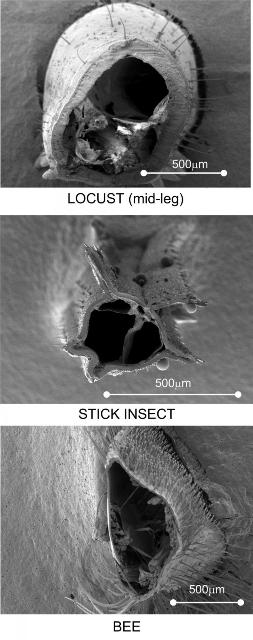Jul 3 2015
A project studying the ways insect legs behave under stress could lead to improved safety in designs of long tubular structures, such as in catheters and aircraft.
 This image shows insect legs reacting differently when stress is applied (electron scanning microscope images). Credit : Prof David Taylor, Trinity College Dublin
This image shows insect legs reacting differently when stress is applied (electron scanning microscope images). Credit : Prof David Taylor, Trinity College Dublin
The study was carried out by a team at Trinity College, Dublin. Professor David Taylor, one of the lead researchers, said:
"Thin-walled tubes are prone to failure by buckling. It is difficult to predict the loading conditions which cause buckling, especially for tubes of non-standard cross section. Think of a drinking straw. If you bend it, it will suddenly give."
The researchers chose a range of insects to study, representing a variety of leg shapes and types, and covering different activities. The insects studied included cockroaches, locusts, bees and stick insects.
Stick insects possess five longitudinal ridges along the length of their legs. Taylor commented:
"We discovered that these ridges do not prevent buckling, but they do help the legs stay intact. In particular, they help resist a particular type of buckling called elastic buckling. This shows how material properties and geometry can interact in complex ways, which must be taken into account when designing thin-walled tubes."
On the other hand, the legs of bees have a triangular cross section containing a large flat area with a pollen basket. The researchers discovered that this did not drastically influence the bending moment to failure, thereby proving that non-circular cross sections can be manufactured without affecting the mechanical strength.
Cockroaches and locusts possess hollow legs containing near-circular cross sections, which approach the limit they can handle, almost breaking. Taylor called this "evolution operating close to the edge".
By understanding insect cuticles, the team hopes that the information will influence future biomimetic materials. "Even though the arthropod cuticle is one of the most common materials in the world, we don't know very much about it", said Taylor.
Going forward, this research team will be testing the ways in which living insects react to stress.